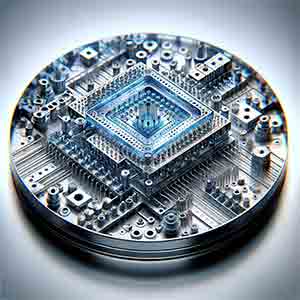I would like to quote thermal oxide coated Silicon wafers, with a 500 nm silicon oxide layer, I don't know if they have them, if not the ones that are SiO2 thicker layer.
What Substrates are Used in BioMEMS?
Thermal Oxide Coated Silicon Wafers for BioMEMS Research
An electrical engineering professor requested a quote for the following:
UniversityWafer, Inc. Quoted:
100mm P(100) 500+/-25um SSP 1~30 ohm-cm SSP with 500nm silicon oxide layer
We provide the substrates that help researchers miniaturize platforms to modulate and monitor cell and tissue behavior in normal and pathological states.
Reference #277243 for specs and pricing.
Get Your Quote FAST! Or, Buy Online and Start Researching Today!
Fused Quartz Substrates to Fabricate BioMEMS
A startup requested help sourcing 200mm quarts wafers.
Our business is developing innovative devicesin micro and nanofabrication including life science applications like lab-on-a-chip and bioMEMS. We also provide short run services for research and prototyping of wafer-based devices.
Can you quote ten 200mm quartz wafers?
Reference #142667 for specs and pricing.
Nitride Coated Silicon Wafers (SiN) to Fabricate BioMEMS
A research assistant from a Biosendor and BioMEMS lab requested the following quote.
We have an immediate need for a few silicon wafers with a nitride or a nitride/oxide coating for our BioMEMS project. Probably any nitride (PECVD preferred) with a layer thickness over 2000A would do, without or without an oxide under layer, 5" or 6" diameter standard silicon, DSP or SSP, P-doped is better than N, and almost any resistance. 3 or 4 would be great, even 2 would help, we would buy a partial boat if you have one at a good price.
500nm of oxide seem to be the preferred oxide thickness for BioMEMS applications.
Reference #150099 for specs and pricing.
Soda Lime Glass For Fabricating BioMEMS Sensors
I'm research assistant from Biosensor and BioMEMS LAB, and I'm founded some wafers from your website.
Could you issue me the qourt of these items below?
Item #1631 Soda lime Glass - 25EA
Soda lime Glass 100mm 550um DSP
Reference #201752 for specs and pricing.
Silicon Wafers for BioMEMS Research
A PhD student requested the following quote:
I have a budget that we need to spend $ for research before the end of this month. I would like to get a quotation for the wafer below: 100mm, double polish, ~400um thick. Any type of doping and no problem with resistance.
100mm (N or P) [100] 380-400um DSP any resistance ohm-cm
Please let me know as soon as possible.
Reference #177676 for specs and pricing.
What Substrates are Used to Fabricate BioMEMS?
BioMEMS, which stands for Biological MicroElectroMechanical Systems, are typically fabricated using a  variety of substrates depending on their intended application and functionality. Common substrates used in the fabrication of BioMEMS include:
variety of substrates depending on their intended application and functionality. Common substrates used in the fabrication of BioMEMS include:
-
Silicon: Silicon is a widely used substrate in MEMS technology due to its excellent mechanical properties, well-established fabrication processes, and compatibility with microelectronics. For BioMEMS, silicon can be used to create microstructures, sensors, and actuators.
-
Glass: Glass is another popular substrate due to its transparency, which is advantageous for optical applications, and its biocompatibility. Glass substrates are often used in microfluidic devices and for cell culture platforms.
-
Polymers: Various polymers are used in BioMEMS for their flexibility, biocompatibility, and ease of fabrication. Common polymers include PDMS (polydimethylsiloxane), PMMA (polymethyl methacrylate), and SU-8. These materials are particularly useful in soft lithography and for creating flexible or disposable devices.
-
Ceramics: Certain ceramic materials are used in BioMEMS, especially for applications requiring high temperature stability or specific electrical properties. Alumina and zirconia are examples of ceramics used in some BioMEMS devices.

Biodegradable Materials: For implantable or transient devices, biodegradable materials are sometimes used. These materials can degrade safely in the body after serving their purpose, minimizing the need for surgical removal.
-
Metals: Metals like gold, platinum, and titanium are used in BioMEMS for electrodes, sensors, and other components requiring electrical conductivity and biocompatibility.
Each of these substrates offers unique properties and is chosen based on the specific requirements of the BioMEMS device, such as mechanical strength, biocompatibility, electrical properties, and compatibility with biological systems or fluids.
Fused Silica Substrates: Paving the Way for Advanced BioMEMS Devices in Heat-Related Health Monitoring
BioMicroElectroMechanical Systems (BioMEMS) are at the forefront of revolutionizing medical technology, and fused silica substrateshave emerged as a critical component in their fabrication. With their unique properties, these substrates are enabling the development of futuristic devices designed to alert individuals to potential heat-related health issues, including heat exhaustion and heat stroke.
The Superiority of Fused Silica Substrates
Fused silica, known for its exceptional thermal stability and chemical inertness, stands out as an ideal material  for sensitive medical devices. Its low thermal expansion coefficient ensures minimal dimensional changes in varying temperatures, crucial for devices that operate close to human body temperature. Additionally, its high corrosion resistance makes it safe for prolonged contact with human skin and tissues.
for sensitive medical devices. Its low thermal expansion coefficient ensures minimal dimensional changes in varying temperatures, crucial for devices that operate close to human body temperature. Additionally, its high corrosion resistance makes it safe for prolonged contact with human skin and tissues.
BioMEMS and Heat-Related Health Monitoring
BioMEMS devices rely on precise measurements and stable operation, making fused silica substrates an optimal choice. These devices can monitor physiological parameters such as body temperature, sweat composition, and heart rate, which are critical in detecting early signs of heat-related illnesses.
Early Detection of Heat Exhaustion and Heat Stroke
Heat exhaustion and heat stroke are serious conditions that can escalate rapidly without timely intervention. Future BioMEMS devices built on fused silica substrates could provide continuous monitoring, offering real-time alerts to users at the onset of these conditions. This early warning system is particularly beneficial for vulnerable populations such as athletes, outdoor workers, and the elderly.
Integrating with Wearable Technology
The integration of these substrates into wearable technology, such as smartwatches or patches, can make continuous health monitoring both unobtrusive and convenient. With advancements in wireless communication, these devices could potentially send alerts not only to the wearer but also to healthcare providers or emergency contacts.
Technical Specifications of Fused Silica in BioMEMS
The technical specifications of fused silica, including its dielectric properties, optical transparency, and biocompatibility, make it uniquely suitable for BioMEMS applications. These properties enable the creation of devices that are not only effective in monitoring health parameters but also safe and comfortable for everyday wear.
The Future of Healthcare Monitoring
As research and development in BioMEMS technology continue to advance, the potential applications of fused silica substrates are vast. The focus on developing devices for heat-related health monitoring is just one example of how this technology can contribute to preventative healthcare and enhance the quality of life.
Conclusion
Fused silica substrates are set to play a pivotal role in the next generation of BioMEMS devices, particularly in the realm of health monitoring. Their unique properties make them an invaluable material in the fabrication of devices that can detect and alert individuals to potential heat-related health issues. As technology progresses, we can expect to see more innovative applications of fused silica in various medical devices, ultimately contributing to a safer and healthier society.
The market for BioMEMS (Biological MicroElectroMechanical Systems) has undergone significant evolution and expansion in recent years, driven by advancements in microfabrication technologies and the increasing demand for personalized healthcare solutions.
Current State of the BioMEMS Market
-
Diversification of Applications: Originally centered around medical diagnostics and drug delivery systems, BioMEMS now find applications in various fields such as wearable health monitors, implantable devices, and even environmental sensing. This diversification reflects the growing intersection of healthcare, technology, and consumer needs.
-
Integration with Consumer Electronics: There's a notable trend in integrating BioMEMS with everyday consumer electronics, especially wearables. Smartwatches and fitness bands equipped with BioMEMS sensors can monitor vital signs like heart rate, blood oxygen levels, and even stress levels, making preventive healthcare more accessible.
-
Advancements in Personalized Medicine: BioMEMS play a crucial role in the burgeoning field of personalized medicine. They enable precise drug delivery and real-time monitoring of bodily functions, tailoring healthcare to individual patient needs.
-
Growth in Implantable Devices: The demand for implantable BioMEMS devices, such as glucose monitors and cardiac monitors, has increased. These devices offer continuous monitoring for chronic conditions, greatly improving patient quality of life.
Future Prospects
-
Expansion into Telehealth: With the rise of telehealth, BioMEMS are expected to play a vital role in remote patient monitoring, offering real-time data transmission to healthcare providers and ensuring timely medical intervention.
-
Potential in Emerging Markets: As healthcare infrastructure improves in emerging economies, the demand for affordable and efficient medical technologies like BioMEMS is likely to surge, opening new markets and opportunities.
-
Advances in Nanotechnology: Ongoing research in nanotechnology promises to make BioMEMS devices more efficient, smaller, and more cost-effective, potentially revolutionizing how we approach diagnostics and treatment.
-
Collaborations and Partnerships: Increasing collaborations between tech companies and healthcare providers are likely to drive innovation and application of BioMEMS, making them more integrated into healthcare systems.
Challenges and Considerations
- Regulatory Hurdles: As with any medical technology, BioMEMS face stringent regulatory processes, which can be a barrier to rapid commercialization.
- Data Security and Privacy: With BioMEMS collecting sensitive health data, ensuring data security and patient privacy is paramount.
- Cost and Accessibility: Making these technologies affordable and accessible to a broader population remains a challenge that the industry must address.
In conclusion, the BioMEMS market is at a dynamic and promising juncture, with potential applications that extend far beyond traditional healthcare settings. As technology continues to advance, BioMEMS are poised to become integral components in the future landscape of healthcare and wellness.
